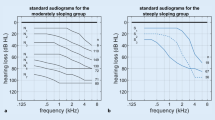Abstract
The Freiburger Speech Test (FST) has been the gold standard in speech testing by word recognition score in Germany for many years. Recently, it has been demonstrated that for an amount of 104 test-persons there is no significant deviation within the lists. The objective of this study was to determine the percentiles of the distinct measuring situations in quiet and with noise (e.g. applied in hearing aid fitting) and the average benefit using hearing aids. In this prospective study, 623 patients with SNHL and equipped with hearing aids for at least 3 months have been investigated by means of the Freiburger monosyllabic test (FBE) without and with hearing aids and in quiet or with noise (CCITT noise, 65/60 dB signal–noise ratio) in free field conditions at 65 dB to determine the ratio of intelligibility. To investigate the different diagnostic conditions a linear mixed model was applied. The dependent binary variable corresponds to the number of understood syllables. The average age of all subjects was about 72.6 years. The average rate of understanding in the FBE without hearing aids and in quiet was 38.5 %, with hearing aids and in quiet 67.7 %, without hearing aids and with noise 22.4 %, and with hearing aids and with noise 39.8 %. All results were presented with the depending confidence intervals. The extent of hearing loss and the quality of hearing aid fitting can be successfully measured using the FST in quiet and with background noise (CCITT noise). In quiet, an average hearing improving gain of 29.2 % points and with noise a gain of 17.4 % points could be estimated with a successful hearing aid fitting.


Similar content being viewed by others
References
Baiduc RA, Poling GL, Hong O, Dhar S (2013) Clinical measures of auditory function: the cochlea and beyond. Dis Month 59:147–156
Picheny MA, Durlach NI, Braidda LD (1985) Speaking clearly for the hard of hearing I: intelligibility differences between clear and conversational speech. J Speech Hear Res 28:96–103
Freyman RL, Helfer KS, McCall DD, Clifton RK (1999) The role of perceived spatial separation in the unmasking of speech. J Acoust Soc Am 106:3578–3588
Taylor BJ (2003) Speech in noise tests: how and why to include them in your basis test battery. Hear J 56:40–46
Hahlbrock KH (1953) Über Sprachaudiometrie und neue Wörterteste. Arch Ohren Nasen Kehlkopfheilkd 162:394–431
Bangert H (1980) Probleme bei der Ermittlung des Diskriminationsverlustes nach dem Freiburger Sprachtest. Audiol Akustik 19:166–170
Ahlich G (1985) Anmerkungen zum Freiburger Sprachverständnistest. Sprache Stimme Gehör 9:1–6
Sesterhenn G (1985) in [9]
Wedel H (1986) Untersuchungen zum Freiburger Sprachtest-Vergleichbarkeit der Gruppen im Hinblick auf Diagnose und Rehabilitation (Hörgeräteanpassung und Hörtraining). Audiol Akustik 25:60–73
Hahlbrock H (1970) Sprachaudiometrie. Grundlagen und praktische Anwendung einer Sprachaudiometrie für das deutsche Sprachgebiet, 2nd edn. Georg Thieme, Stuttgart
Brinkmann K (1974) Die Neuaufnahme der “Wörter für Gehörprüfung mit Sprache”. Z Audiologie 13:12–40
DIN EN ISO 45626-1 (1995) Tonträger mit Sprache für Gehörprüfung. part 1: Tonträger mit Wörtern nach DIN 45621-1 (Aufnahme 1969). Beuth, Berlin
Böhme G, Welzl-Müller K (2004) In: Audiometrie. Hörprüfungen im Erwachsenen-und Kindesalter, 5th edn. Verlag Hans Huber, Bern
Löhler J, Akcicek B, Pilnik M, Saager-Post K, Dazert S, Biedron S, Oeken J, Mürbe D, Löbert J, Laszig R, Langer Ch, Wesarg Th, Plontke S, Rahne T, Machate U, Noppeney R, Schultz K, Plinkert P, Hoth S, Praetorius M, Schlattmann P, Meister EF, Pau HW, Ehrt K, Hagen R, Shehata-Dieler W, Cebulla M, Walther LE, Ernst A (2012) Die Evaluation des Freiburger Einsilbertests im Störschall. HNO 61:586–591
Kollmeier B, Wesselkamp M (1997) Development and evaluation of a German sentence test for objective and subjective speech intelligibility assessment. J Acoust Soc Am 102:2412–2421
Thiele C, Sukowski H, Lenarz T, Lesinski-Schiedat A (2012) Göttinger Satztest im Störgeräusch für verschiedene Gruppen von Schwerhörigkeit. Laryngo Rhino Otol 91:782–788
Mrowinski D, Scholz G (2005) Sprachaudiometrie. In: Audiometrie-Eine praktische Anleitung, Georg Thieme, Stuttgart
Kollmeier B, Lenarz T, Winkler A, Zokoll MA, Sukowski H, Brand T, Wagener KC (2011) Hörgeräteindikation und-überprüfung nach modernen Verfahren der Sprachaudiometrie im Deutschen. HNO 59:1012–1021
Kießling J (2010) Moderne Sprachtests auf dem Weg von der Forschung in die Praxis. HNO 58:595–596
Killion MC (2002) New thinking on hearing in noise: a generalized articulation index. Semin Hear 23:57–75
Wilson RH, McArdle R (2005) Speech signals used to evaluate the functional status of the auditory system. J Rehabil Res Dev 42:79–94
DIN EN ISO 8253-1 (2011) Akustik—Audiometrische Prüfverfahren—part 1: Grundlegende Verfahren der Luft-und Knochenleitungs-Schwellenaudiometrie mit reinen Tönen. Beuth, Berlin
DIN EN ISO 8253-2 (2010) Akustik—Audiometrische Prüfverfahren—Part 2: Schallfeld-Audiometrie mit reinen Tönen und schmalbandigen Prüfsignalen. Beuth, Berlin
DIN EN ISO 8253-3 (2012) Akustik—Audiometrische Prüfverfahren—Part 3: Sprachaudiometrie. Beuth, Berlin
DIN EN ISO 7029:2000 (2001) Akustik-Statistische Verteilung von Hörschwellen als ei ne Funktion des Alters. Beuth, Berlin
http://www.g-ba.de/informationen/richtlinien/13/. Accessed 11 Apr 2014
ITU-T Recommendation G.227, International analogue carrier systems—general characteristics common to all analogue carrier-transmissio systems—conventional telephone signal. http://www.itu.int/rec/T-REC-A.15-198811-S
Skrondal A, Rabe-Hesketh S (2009) Prediction in multilevel generalized linear models. J R Statist Soc A 172:659–687
R Core Team, R Foundation for Statistical Computing (2013) R: A language and environment for statistical computing. Vienna, Austria http://www.R-project.org/
Schwarzer G (2013) Meta-Analysis with R. R pac kage version 2.3-0. http://CRAN.R-project.org/package=meta. Accessed 11 Apr 2014
Lehnardt E, Laszig R (2009) Praxis der Audiom etrie. Georg Thieme, Stuttgart
http://www.g-ba.de/downloads/40-268-1897/2012-03-15_HilfsM-RL_Neufassung-Hoerhilfen_TrG.pdf. Accessed 11 Apr 2014
Conflict of interest
There is no conflict of interest.
Author information
Authors and Affiliations
Corresponding author
Additional information
In the honor of Prof. Dr med. Karl-Heinz Hahlbrock (14 October 1917–27 July 2003) in memoriam on the 60th anniversary of the publication “Über Sprachaudiometrie und neue Wörterteste” [“On Speech Audiometry and New Word Tests”] published in 1953.
Rights and permissions
About this article
Cite this article
Löhler, J., Akcicek, B., Wollenberg, B. et al. Results in using the Freiburger monosyllabic speech test in noise without and with hearing aids. Eur Arch Otorhinolaryngol 272, 2135–2142 (2015). https://doi.org/10.1007/s00405-014-3039-x
Received:
Accepted:
Published:
Issue Date:
DOI: https://doi.org/10.1007/s00405-014-3039-x




